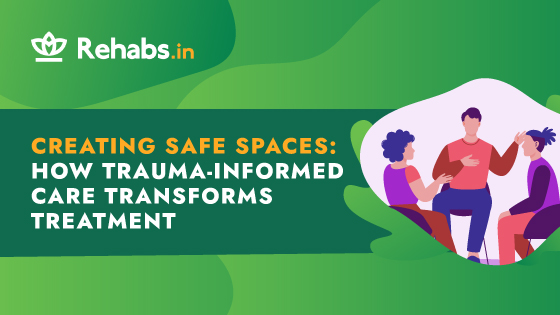Creating Safe Spaces: How Trauma-Informed Care Transforms Treatment

Trauma-informed care (TIC) is an approach that recognises how deeply trauma can affect a person’s well-being and aims to create an environment that promotes healing.
You might not realise it, but trauma is more common than we often think. Research suggests that up to 70% of people will experience a traumatic event at some point in their lives, whether it’s an accident, abuse, or a significant loss. These experiences can have lasting effects on your mental, emotional, and even physical health. The way you respond to treatment can depend heavily on how safe and supported you feel in that environment. Trauma-informed care focuses on making sure that spaces are not just physically safe but emotionally safe, too, reducing the risk of being re-traumatised during treatment.
In this blog, we’ll explore how trauma-informed care transforms treatment by creating safe spaces that are essential for healing.
The Core Principles of Trauma-Informed Care
Trauma-informed care (TIC) is built around several key principles designed to ensure that you feel safe, supported, and understood throughout your treatment. These principles are grounded in research and are essential for helping you heal without being re-traumatised. Let’s break down the core principles of TIC and how they make a difference in your care.
1. Safety
The first and most important principle of trauma-informed care is safety. This means creating an environment where you feel physically and emotionally secure. In a trauma-informed setting, the staff is trained to recognise that trauma can make you more sensitive to certain situations, so they work to ensure that you feel comfortable and protected at all times. This might involve clear communication about what’s happening during sessions or designing the space in a way that feels open and welcoming, avoiding any elements that might feel threatening or distressing to you.
2. Trustworthiness and Transparency
One of the most challenging parts of trauma can be learning to trust again. Trauma-informed care focuses on building trust by being transparent and predictable in every interaction. Your therapist or healthcare provider should always explain what they’re doing, why they’re doing it, and what you can expect next. By maintaining clear, open communication, TIC helps rebuild trust, making you feel more in control of your treatment.
3. Peer Support
Research shows that peer support—connecting with others who have gone through similar experiences—can play a powerful role in recovery. In trauma-informed care, the value of shared experiences is recognised. You might find that being part of a group where others understand what you’ve been through makes you feel less alone and more supported. Peer support helps foster connection, and connection is essential for healing.
4. Collaboration and Mutuality
In trauma-informed care, you’re seen as an active participant in your own treatment. This principle emphasises collaboration between you and your care provider. Instead of being told what to do, you’re encouraged to be part of the decision-making process. This mutual approach helps restore your sense of control, which is often lost after experiencing trauma. You and your therapist work together, which helps you feel empowered and respected.
5. Empowerment, Voice, and Choice
When you’ve experienced trauma, you might feel like your choices have been taken away from you. Trauma-informed care prioritises giving you back your voice and empowering you to make choices about your treatment. This principle is all about helping you feel in control again. Whether it’s deciding the pace of your therapy or choosing which strategies to use, your input matters. Feeling empowered can significantly improve your engagement and progress in treatment.
6. Cultural, Historical, and Gender Sensitivity
Your background and identity shape your experiences with trauma, and trauma-informed care recognises this. Whether it’s your cultural background, gender identity, or personal history, these factors are respected and considered throughout your treatment. Research shows that trauma can be exacerbated by systemic issues like racism, sexism, or historical trauma, so TIC ensures that your care is tailored to reflect your unique experiences. This sensitivity helps create a space where you feel seen, heard, and understood.
How Trauma-Informed Care Transforms Treatment
Trauma-informed care (TIC) doesn’t just change the way you’re treated—it transforms the entire approach to care in a way that prioritises your safety, dignity, and emotional well-being. By shifting the focus from simply treating symptoms to understanding your experiences, TIC creates a more supportive and effective healing environment. Here’s how trauma-informed care makes a real difference in treatment.
Shifting the Focus: From “What’s Wrong with You?” to “What Happened to You?”
Traditional care often focuses on diagnosing problems and fixing them. Trauma-informed care takes a different approach by asking, “What happened to you?” instead of “What’s wrong with you?” This shift recognises that your symptoms and behaviours are often responses to past trauma, not personal failings. By focusing on your life experiences, TIC helps you feel understood and validated, which is essential for recovery. This perspective allows your therapist to better tailor treatment to address the root causes of your struggles rather than just managing surface-level symptoms.
Building Trust and Emotional Safety
Trauma often damages your sense of trust in others, making it harder to open up and engage in treatment. TIC emphasises creating a safe and trusting relationship between you and your therapist. This means that your therapist will always be transparent, explain each step of the process, and give you choices in how your treatment unfolds. Research shows that when you feel safe and in control, you’re more likely to stay engaged in therapy and experience better outcomes. In TIC, your emotional safety is just as important as the treatment itself.
Reducing Retraumatization
One of the most critical aspects of trauma-informed care is preventing re-traumatisation—situations where you might unintentionally re-experience feelings of trauma during treatment. Without TIC, common practices in healthcare or therapy might trigger traumatic memories or responses. For example, a setting that feels restrictive or a therapy method that moves too fast can make you feel unsafe or out of control. Trauma-informed care minimises these risks by recognising your triggers and adjusting the treatment environment and methods to keep you feeling secure.
Improving Treatment Outcomes
When you feel safe, respected, and involved in your own care, you’re more likely to see positive results from treatment. Research has shown that trauma-informed care can lead to better mental health outcomes, greater trust in healthcare providers, and higher rates of treatment engagement. For example, studies have found that clients who receive trauma-informed care are more likely to complete their therapy and report feeling more satisfied with the care they receive. This approach helps you stay committed to the healing process because it centres your needs and experiences.
Empowering You in the Healing Process
One of the most transformative aspects of trauma-informed care is its emphasis on empowerment. When you’ve experienced trauma, you might feel like you’ve lost control over your life. TIC actively works to restore that sense of control by giving you a voice in your treatment. Whether it’s deciding what goals you want to focus on or having a say in the therapeutic techniques used, you’re seen as a partner in your own healing. This empowerment is crucial because it helps rebuild your confidence and self-agency, which are key to long-term recovery.
Building Safe Spaces Through Trauma-Informed Care (TIC)
Creating a space where you feel physically and emotionally safe is at the heart of trauma-informed care (TIC). When you’ve experienced trauma, feeling vulnerable in any setting can make it harder for you to trust, open up, and engage in treatment. Trauma-informed care prioritises building environments that help you feel secure, respected, and in control, which are all essential for your healing journey. Here’s how TIC helps create safe spaces:
Creating a Welcoming Environment
One of the first things you notice when you walk into a treatment space is how it feels. Is it welcoming? Does it feel like a safe space where you can relax? In TIC, the physical environment is designed to make you feel comfortable and at ease. This might include creating open, well-lit spaces with calming colours, reducing harsh lighting, and arranging the space in a way that feels inviting and non-threatening.
A trauma-informed setting also minimises elements that could trigger traumatic memories. For example, TIC providers are mindful of avoiding loud noises, crowded waiting areas, or settings that feel overly clinical, as these can make you feel anxious or unsafe. Every effort is made to ensure that the space supports your sense of calm and safety from the moment you enter.
Promoting Emotional Safety
Emotional safety is just as important as physical safety. Trauma-informed care is built on the understanding that treatment can be overwhelming, especially if it reminds you of past trauma. TIC professionals are trained to create an emotionally safe space by using compassionate communication, active listening, and validating your experiences.
In a trauma-informed setting, your therapist won’t rush you or push you into sharing before you’re ready. Instead, they give you time to express yourself at your own pace. Research shows that this kind of patient-centred approach reduces anxiety and helps you feel more in control of your treatment, which is essential for building trust and emotional safety.
Respecting Boundaries
In trauma-informed care, respecting your personal boundaries is critical. Trauma often involves a violation of boundaries, whether emotional, physical, or psychological. In TIC, your therapist or provider makes sure that you feel comfortable with every step of your treatment. You won’t be asked to do anything that makes you feel uncomfortable or unsafe. Instead, you have the power to set limits on what you’re willing to share or explore in therapy.
For example, if certain topics or therapeutic exercises feel too overwhelming, your therapist will respect your decision to take a break or approach them at a slower pace. This emphasis on boundaries helps you regain a sense of control and trust, which is often lost after trauma.
Training Staff to Understand Trauma
Creating safe spaces also means having staff who understand how trauma affects you and others seeking care. In trauma-informed care, staff members—from receptionists to therapists—are trained to recognise the signs of trauma and respond in ways that make you feel supported rather than judged or misunderstood.
For instance, if you’re anxious or on edge, TIC-trained staff are more likely to offer calming support instead of viewing your behaviour as difficult or disruptive. This understanding ensures that everyone involved in your care is working to make you feel safe and respected, no matter where you are in your healing process.
Supporting Personal Choice and Empowerment
A key part of building a safe space is giving you control over your treatment. Trauma can make you feel powerless, but in a trauma-informed setting, you are given choices about your care. Whether it’s deciding the pace of therapy, choosing between treatment options, or simply having a say in how your sessions unfold, you are empowered to make decisions that feel right for you.
Conclusion
Trauma-informed care (TIC) is more than just an approach to treatment. It’s a way to ensure you feel safe, respected, and empowered as you heal. By shifting the focus to understanding your trauma and its impact on your life, TIC helps create spaces where you can rebuild trust, take control of your recovery, and feel supported every step of the way. Whether it’s through a welcoming environment, respect for your boundaries, or involving you in your own care decisions, TIC transforms treatment into a process that not only addresses your symptoms but helps you heal from the root of your trauma.
Ultimately, creating safe spaces isn’t just about providing comfort; it’s about building a foundation for real, lasting change. Trauma-informed care gives you the safety and support you need to not only cope with the effects of trauma but to move beyond them and regain a sense of control over your life. If you’re seeking treatment or supporting someone who is, it’s worth looking for trauma-informed care because everyone deserves to feel safe, valued, and understood in their healing journey.
Sources:
Substance Abuse and Mental Health Services Administration (SAMHSA). (2014). SAMHSA’s concept of trauma and guidance for a trauma-informed approach (HHS Publication No. SMA 14-4884). U.S. Department of Health and Human Services. https://store.samhsa.gov/product/SAMHSA-s-Concept-of-Trauma-and-Guidance-for-a-Trauma-Informed-Approach/SMA14-4884
Fallot, R. D., & Harris, M. (2009). Creating cultures of trauma-informed care (CCTIC): A self-assessment and planning protocol. Community Connections. https://www.theannainstitute.org/CCTICSELFASSPP.pdf
Courtois, C. A., & Ford, J. D. (Eds.). (2013). Treatment of complex trauma: A sequenced, relationship-based approach. Guilford Press.
Hopper, E. K., Bassuk, E. L., & Olivet, J. (2010). Shelter from the storm: Trauma-informed care in homelessness services settings. The Open Health Services and Policy Journal, 3(2), 80–100. https://www.homelesshub.ca/resource/shelter-storm-trauma-informed-care-homelessness-services-settings
Sweeney, A., Filson, B., Kennedy, A., Collinson, L., & Gillard, S. (2018). A paradigm shift: Relationships in trauma-informed mental health services. BJPsych Advances, 24(5), 319–333. https://doi.org/10.1192/bja.2018.29












